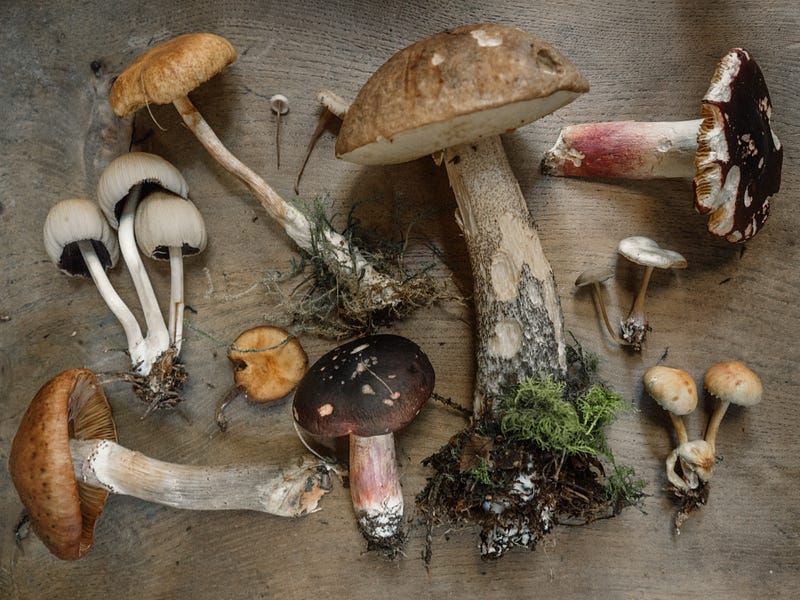Fungi: The Fascinating World of Mushrooms and Their Roles
Written on
Chapter 1: The Misunderstood Mushroom
There's a common phrase in Spanish, "más aburrido que un hongo," which translates to "more boring than a mushroom." This couldn't be farther from the truth, as mushrooms are truly remarkable organisms, and I’m here to explain why.
Fungi, along with animals and plants, comprise one of the three primary groups of eukaryotic life forms. They are incredibly diverse and abundant, ranking just after insects in terms of eukaryotic organisms. Their forms can vary widely—from unicellular species like yeasts to filamentous structures known as hyphae that collectively form mycelia. These can be simple, as seen in molds, or more complex and sizable, like mushrooms and many lichens.
While often likened to plants, fungi are actually more closely related to animals, sharing a common ancestor known as the Opisthokonts. Their primary ecological role is decomposing organic matter, but they also play significant roles as parasites and symbionts. Fungi exhibit a unique nutritional strategy called osmotrophy, which involves external digestion of organic materials.
The origin of fungi remains largely a mystery, with estimates ranging from 400 to 800 million years ago, depending on whether fossil records or molecular clocks are referenced. Interestingly, fungi thrive in various environments around the globe, often influenced by human activities.
Now, let’s delve into the delightful aspects of fungi—they're not just functional but also a source of enjoyment and nourishment!

Chapter 2: Culinary Delights of Fungi
Fungi are highly sought after for their flavor and nutritional benefits. However, it’s essential to know which varieties are safe to consume, as some can be toxic or even deadly. Here are a few popular edible fungi:
- Shiitake: Native to China, these mushrooms are now enjoyed worldwide for their robust flavor, commonly used in soups, stews, sushi, and salads.
- Porcini (Boletus): Renowned in Italian cuisine, these mushrooms have a soft texture and nutty flavor, perfect for salads and risottos.
- Truffle: The most expensive fungus globally, these exquisite ingredients come from the roots of mycorrhizal trees and are prized for their unique flavor in gourmet dishes.
- Mushroom: The most commonly consumed mushroom, easily found in the wild, offers versatility in cooking both raw and cooked.
- Portobello: A larger variety of the common mushroom with a more intense flavor, originating from the Mediterranean.
- Oyster Mushroom: Recognizable by its fan-shaped cap, it features a strong aroma and delicate texture.
Video: Fungi: Why Mushrooms Are Awesome | Biology for Kids - YouTube
This video explores the fascinating qualities of mushrooms, highlighting their ecological importance and culinary uses.
Chapter 3: The Symbiotic Life of Fungi
Fungi also exhibit fascinating symbiotic relationships, particularly with photosynthetic organisms like green algae or cyanobacteria, forming lichens. This partnership benefits both parties: the fungus offers structural support and protection, while the algae provide essential nutrients.
Lichens serve as bio-indicators, reflecting environmental conditions and pollution levels. Their sensitivity to pollutants means that more lichens in an area typically indicate cleaner air and water. Notably, areas experiencing reduced pollution have seen a resurgence of lichen populations.
Video: Legend of Mushroom Deconstructed - How it became a fungal phenomenon - YouTube
This video dives into the cultural significance of mushrooms, illustrating their impact on society and the environment.
Chapter 4: The Dark Side of Fungi
Interestingly, some fungi can manipulate their hosts. The insect-pathogenic fungus Ophiocordyceps unilateralis, known as the "zombie-ant fungus," infects ants, altering their behavior to facilitate the fungus's growth.
Moreover, some fungi can be deadly if consumed. Notable examples include:
- Amanita phalloides: Known as the "death cap," this toxic species closely resembles edible varieties, leading to accidental poisonings. Symptoms can emerge 6 to 12 hours post-consumption, including nausea, jaundice, and potentially death.
- Amanita muscaria: A well-known hallucinogenic mushroom, it can cause gastrointestinal distress and has appeared in popular culture.
The world of fungi is vast and increasingly intriguing, with ongoing research revealing their potential benefits, including therapeutic uses in treating conditions like PTSD. As we continue to explore this remarkable kingdom, we may uncover even more astonishing species and their roles in our world.
Thank you for taking the time to read this article! I’d love to hear your thoughts in the comments below. I often write about biodiversity, sustainability, and captivating scientific topics. If you enjoyed this content, consider joining Medium to discover more articles while supporting authors like me.